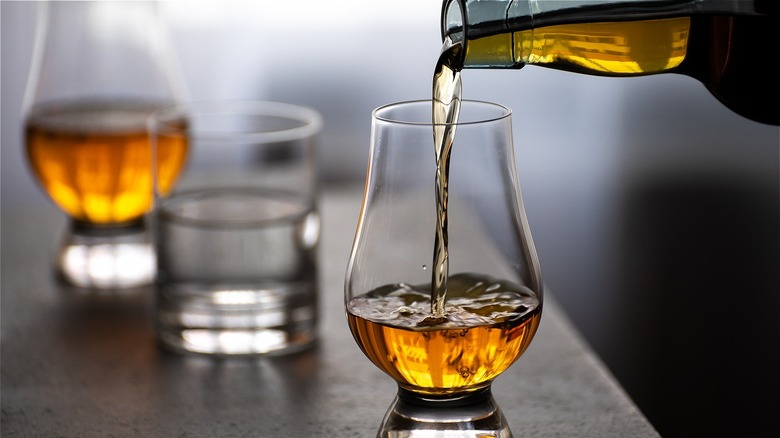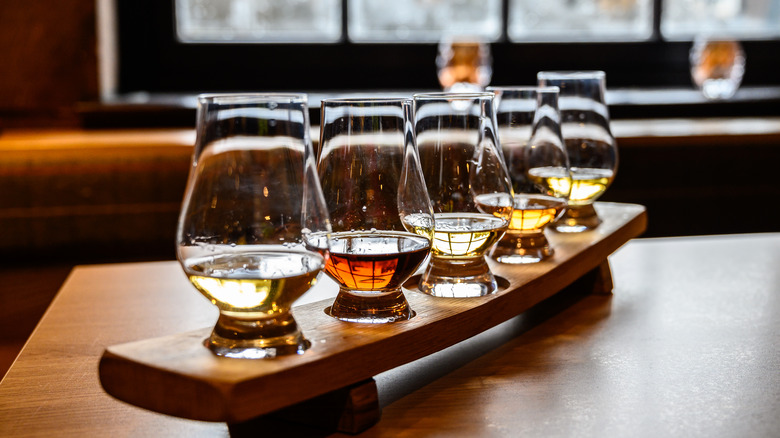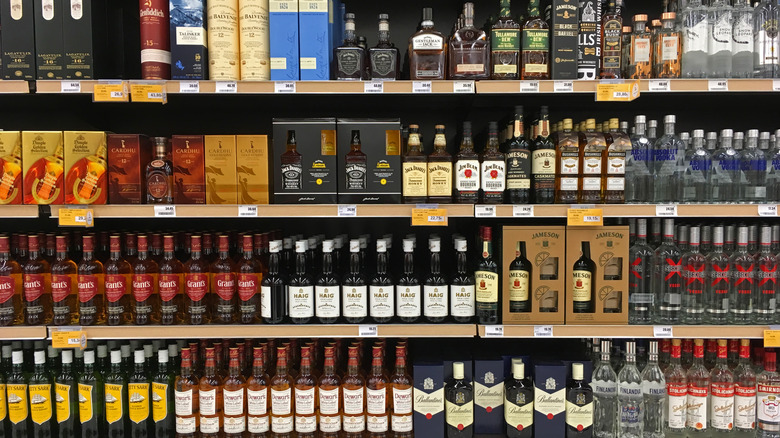What Exactly Is Blended Whiskey?
The shelves of local liquor stores (called package stores or packies in the Northeast) have swelled to make room for the increased demand for whiskey, scotch, bourbon, and rye in America. Although vodka is still the most popular spirit in the U.S., whiskey is estimated to surpass it this year, Forbes reports. However, not all whiskey markets have grown. Tariffs and closures have impacted some markets, but Japanese, Indian, and American brands have seen a spike in demand post-2020.
There are many types of whiskey, which can be divided into domestic and imported varieties, then further divided by region. Local laws and regulations on the type of grain used and the distillation process affect the taste and quality of the spirit. Within the imported aisle, you'll find a selection of the most popular whiskeys from Ireland (from single malt to Single Pot); Scotland (made in the Highlands, Islay, Speyside, and beyond); Canada; and the fastest-growing market, Japan (where they drop the "e" in whisky and create a product similar to scotch).
That's a lot to digest, and we haven't even gotten to domestic whiskey yet! Although small craft distilleries are dotted across the country, there are four main categories of American whiskey, and we've broken that information down, too.
Blended whiskey is a broad type of American whiskey
American whiskey can be categorized as bourbon, Tennessee whiskey, rye, and straight corn whiskey. Per Food & Wine, bourbon, which is whiskey containing 51% or more corn, has no additives other than water and is aged in never-used charred oak barrels for at least two years. Tennessee whiskey is made primarily of corn, has oaky vanilla notes, and is filtered through maple charcoal chunks before being aged in a barrel, resulting in a smooth finish. As VinePair explains, rye is made from 51% or more rye grain, and though it has similar aging requirements as bourbon, rye is found to have a spicier, sharper taste. Finally, straight corn whiskey is made from 80% corn and barreled in oak, though not the new barrels that are required for bourbon and rye (via Master of Malt).
Then there's blended whiskey. According to the United States Code for Intoxicating Liquors (updated in 2020), the standards for a blended whiskey are very loose, but the spirit needs to contain a minimum of 20% whiskey. Aside from that, blended whiskey can contain additives such as other spirits, colors, and flavorings. If the blended whiskey has more than 51% straight whiskey of one kind, the label will indicate that by saying "blended rye whiskey," for example.
How to choose the best blended whiskey
With these standards, how can the consumer know what they are getting from a blended whiskey? This variety is usually less expensive and readily available than other types of whiskey, making it widely popular, per BlackTail NYC. This also means there's a wide range in quality, from the cheaply made and harsh-tasting to the thoughtfully crafted and smooth.
The experts at The Whiskey Wash suggest reading the label to see what's in the bottle. Look for what the blend is composed of; the better brands typically list the types of whiskey, while those that just say "blended" may be hiding a suspicious mix of additives. If you're typically drawn to bourbon or rye, look for labels that indicate a blended bourbon whiskey or blended rye whiskey, as those will be the dominant flavor.
Next, taste the whiskey in the comfort of your own home (hard work, we know) to see if you like it. The bottom line here is that if you enjoy the taste, it's good for you. Enjoy expensive blended whiskeys neat so you can savor the flavor, while the cheaper options could make a great cocktail, like the classic old fashioned.


